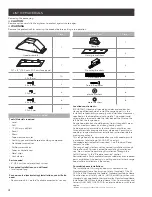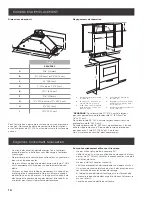
6
Cold weather installations
An additional back draft damper non return valve should be
installed to minimize backward cold air flow and a thermal
break should be installed to minimize conduction of outside
temperatures as part of the vent system. The damper non
return valve should be on the cold air side of the thermal
break.
The break should be as close as possible to where the vent
system enters the heated portion of the house.
Makeup air
Local building codes may require the use of makeup air sys-
tems when using ventilation systems with greater than spe-
cified CFM of air movement. The specified CFM varies from
locale to locale. Consult your HVAC professional for specific
requirements in your area.
Venting methods
This range hood is factory set for venting through the roof
or through the wall. You can apply the recirculating venting
method by purchasing the Recirculation Kit. The vent system
needed for installation is not included.
A 6” (15.2 cm) round vent system is recommended.
Roof venting
Wall venting
A
B
A. 6” (15.2 cm) vent through
the roof
B. Roof cap
A
B
A. 6” (15.2 cm) vent through
the wall
B. Wall cap
Calculate Vent System Length
The recommended vent system is 6” (15.2 cm) round vent
with a maximum length of 35 ft (10.7 m). For the best perfor-
mance, use no more than three 90° elbows.
To calculate the length of the system, add the equivalent feet
(meters) for each of the vent pieces used in the system.
Vent piece
6” (15.2 cm)
45° elbow
2.5 ft (0.8 m)
90° elbow
5.0 ft (1.5 m)
Non-Vented (recirculating) Installations
Through the Soffit/Cabinet
If it is not possible to vent cooking fumes and vapors to the
outside, the range hood can be used in the non-vented
(recirculating) version, using a charcoal filter. Recirculation
Kit is available from the dealer or an authorized parts distributor.
Through Cabinet
Through Soffit
A
B
D
E
F
G
I
H
A
B
C
D
E
F
G
A. Ceiling
B. Vent cover
C. Soffit
D. 6” (15.2 cm) vent
E. Range hood
F. Cabinet
G. Wall
H. 12” (30.5 cm) min.
I. 17” (43.2 cm) min. vent
cover height
*
NOTE
: 12” (30.5 cm) high cabinets without soffit may allow
the 6” (15.2 cm) vent and vent coverto be seen.
Electrical requirements
I
WARNING
PLUG INTO A GROUNDED 3 PRONG OUTLET.
DO NOT REMOVE GROUND PRONG.
DO NOT USE AN ADAPTER.
DO NOT USE AN EXTENSION CORD.
FAILURE TO FOLLOW THESE INSTRUCTIONS CAN RESULT
IN DEATH, FIRE, OR ELECTRICAL SHOCK.
IMPORTANT: The range hood must be electrically grounded in
accordance with local codes and ordinances, or in the absence
of local codes, with the National Electrical Code, ANSI/NFPA
70 (latest edition) or Canadian Electrical Code, CSA C22.1
No. 0-M91 (latest edition).
If codes permit and a separate ground wire is used, it is
recommended that a qualified electrical installer determine
that the ground path is adequate.
A copy of the above code standards can be obtained from:
National Fire Protection Association
1 Batterymarch Park
Quincy, MA 02169-7471
CSA International
8501 East Pleasant Valley Road
Cleveland, Ohio 44131-5575
•
A 120 volt, 60 Hz, AC only, 15- or 20-amp, fused electrical
circuit is required. A time-delay fuse or circuit breaker is
also recommended. It is recommended that a separate
circuit serving only this range hood be provided.
•
This range hood is equipped with a power supply cord
having a 3 prong grounding plug.
•
To minimize possible shock hazard, the cord must be plugged
into a mating, 3 prong, grounding-type outlet, grounded
in accordance with local codes and ordinances. If a mating
outlet is not available, it is the personal responsibility and
obligation of the customer to have the properly grounded
outlet installed by a qualified electrician.
Содержание EAS430SS
Страница 24: ......







































